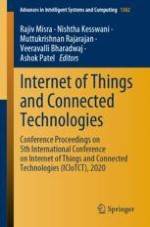This book presents the recent research adoption of a variety of enabling wireless communication technologies like RFID tags, BLE, ZigBee, etc., and embedded sensor and actuator nodes, and various protocols like CoAP, MQTT, DNS, etc., that has made Internet of things (IoT) to step out of its infancy to become smart things. Now, smart sensors can collaborate directly with the machine without human involvement to automate decision making or to control a task. Smart technologies including green electronics, green radios, fuzzy neural approaches, and intelligent signal processing techniques play important roles in the developments of the wearable healthcare systems. In the proceedings of 5th International Conference on Internet of Things and Connected Technologies (ICIoTCT), 2020, brought out research works on the advances in the Internet of things (IoT) and connected technologies (various protocols, standards, etc.). This conference aimed at providing a forum to discuss the recent advances in enabling technologies and applications for IoT.
